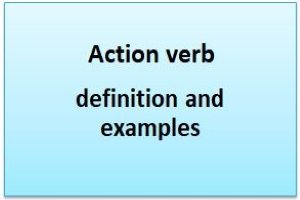Action verb definition and examples:
These verbs are used to represent specific acts by describing what happens in a sentence. We can use it to express someone doing something.
Some common examples of Action verbs.
- Listen
- Think
- Smile
- Run
- Slide
- Do
- Go
- Stand
- Dance
- Jump
Examples of Action verbs In Sentences.
- We run faster than you.
- She does it very well.
- He thinks about parties all day long.
- I wrote a letter to the School principal requesting four days of sick leave. (The verb ‘wrote’, used in the simple past form, is the action verb in the sentence)
NOTE: Understanding the two types of action verbs, their functions in sentences, and how they differ from linking verbs is very essential and important.
Two categories of action verbs:
There are two types of action verbs:
Transitive verbs.
Intransitive verbs.
To explain a complete 100% concept, subject, and verb are most needed in the sentences. The statement, however, becomes more detailed when direct and indirect objects are added.
Transitive verbs:
Transitive verbs are action verbs that always express activities that relate to or influence another person or thing. This type of verb has a direct object, the object could be a nonliving thing) or living thing that is being acted upon. In the 1st example below direct object is Shan. Direct objects, nouns, or pronouns are also influenced by verbs.
For example:
- Shan poked Jasmine in the eye.
Poked is a transitive verb in this example, it means it transfers the action of poking directly to Jasmine. The person being poked is Shan, who is the direct object in the above example.
Here the direct object answers “What?” or “Who?” in the sentences.
- Your cat chewed my shoes. (What did she chew?)
- Helly chose you to be her partner. (Who did she choose?)
- Why did her grandfather call my mother? (What did he call?)
- She painted the fence orange. (What did she paint?)
- Adam married a girl. (Who did he marry?)
The verbs are immediately followed by a direct object that receives the action in each of the sentences above. Transitive verbs have a direct effect on things and people.
Intransitive verbs:
Intransitive verbs are verbs that do not take a direct object. That is, they cannot be used with a noun to form a complete sentence. For example, the verb “sleep” is intransitive because you cannot sleep something. You can only sleep. Similarly, the verb “run” is intransitive because you cannot run something. You can only run.
Intransitive verbs are often used with adverbs to describe the manner in which the action is carried out. For example, you can sleep soundly, sleep deeply, or sleep fitfully. You can run quickly, run slowly, or run awkwardly.
In a few cases, an intransitive verb can be used with a direct object if the object is a pronoun. For example, you can sleep yourself, run yourself, or wake yourself up. However, you cannot sleep on the bed, run the table, or wake the house up.

